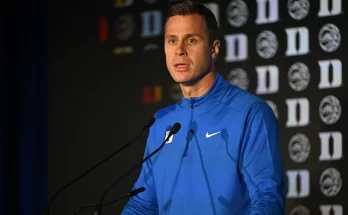Last season, the Boston Celtics emerged as one of the NBA’s strongest contenders, showcasing a blend of young talent, veteran leadership, and strategic coaching that had fans and analysts alike envisioning a deep playoff run. With a roster featuring key players who delivered impressive performances throughout the year, the Celtics were positioned not only as a team capable of competing for an Eastern Conference title but also as a legitimate threat for the NBA championship. However, as the new season approached, a noticeable shift began to take shape within the organization. What once looked like an aggressive push for immediate glory gave way to a more cautious and financially conscious approach, marked by budget cuts and a reevaluation of long-term strategy. This transition, while surprising to some, reflects the complex balancing act teams must perform between pursuing success on the court and maintaining sustainable operations off it.
The Celtics’ strong showing last season was the product of several factors. First and foremost, the team’s core roster demonstrated remarkable cohesion and depth. Talented stars like Jayson Tatum and Jaylen Brown consistently delivered high-level performances, combining scoring prowess, defensive tenacity, and leadership qualities. Their development into bona fide NBA superstars gave the Celtics a foundation that many teams could only envy. Alongside them, veterans and role players stepped up to fill essential roles, whether it was through clutch shooting, solid defense, or facilitating ball movement. The coaching staff, led by Ime Udoka, implemented systems that maximized the roster’s strengths while masking some of its weaknesses, resulting in an efficient, hard-to-beat team.
Throughout the season, Boston’s performances impressed analysts, as the Celtics showcased resilience and adaptability in key moments. Their style of play, marked by smart offense and gritty defense, allowed them to outmatch many opponents and claim important victories. Fans filled arenas, energized by the prospect of finally recapturing a championship that had eluded the franchise for over a decade. The city rallied around the team, with hope running high for a historic playoff run. All signs pointed toward the Celtics continuing their rise, with management seemingly committed to investing in talent and maintaining a competitive roster.
Yet, as the offseason progressed, whispers of financial restraint began to surface. The NBA’s landscape is ever-changing, influenced by salary cap limitations, luxury tax penalties, and the need for long-term roster flexibility. For Boston, these financial realities forced a reassessment of priorities. Despite the on-court success, the team faced decisions that would temper their spending habits and reshape their approach to roster construction. Budget cuts became a noticeable theme, signaling a departure from the aggressive acquisition strategies that often accompany a championship push.
One significant factor in this shift was the constraints imposed by the salary cap and luxury tax system. The NBA operates under a structured financial framework designed to maintain competitive balance, but this system also places strict limits on how much teams can spend on player salaries. For a franchise like the Celtics, which had already committed large contracts to its star players, the luxury tax penalty threatened to become a costly burden. This tax, applied to teams whose payroll exceeds a set threshold, can accumulate into tens of millions of dollars, impacting the overall financial health of the organization.
Faced with the prospect of paying exorbitant luxury taxes, the Celtics’ management opted for prudence. Instead of pursuing expensive free agents or offering big contracts to retain certain role players, the team began exploring more cost-effective options. This approach included targeting younger players on rookie contracts, signing veterans on minimum deals, and prioritizing internal development over external acquisitions. While this strategy might not yield immediate championship results, it positions the franchise to remain financially viable and flexible in the long term.
Another key element driving the budget-conscious approach was the organization’s broader vision for sustained success. Winning an NBA championship requires not only assembling a talented roster but also maintaining depth, managing injuries, and building a culture of excellence. The Celtics’ front office understands that reckless spending can jeopardize these objectives by limiting their ability to make future moves or respond to unforeseen challenges. By exercising financial discipline, Boston aims to keep its core intact while preserving assets—such as draft picks and cap space—that could prove invaluable in the coming years.
This strategic pivot was not without controversy or risk. Fans who had grown accustomed to seeing the Celtics as top-tier contenders found the budget cuts unsettling. Questions arose about whether the team was signaling a step back in ambition or settling for mediocrity. Critics argued that failing to invest in proven talent could undermine the team’s chances of building on last season’s momentum. After all, other franchises continue to spend aggressively to enhance their rosters, and the NBA’s competitive landscape remains unforgiving. If Boston scaled back too much, they risked falling behind in a league where small margins often separate playoff success from disappointment.
Despite these concerns, the Celtics’ management remains confident that their approach is both prudent and effective. The focus on developing young players like Tatum and Brown, combined with smart role-player acquisitions, aims to create a sustainable model of success. The front office is betting that maintaining financial flexibility will allow the team to capitalize on future opportunities—whether through trades, free agency, or draft day deals. This patient, calculated approach acknowledges that while immediate glory is desirable, building a championship contender capable of enduring success requires balance and foresight.
In addition, the team’s culture and coaching remain strong pillars that support this transition. Ime Udoka and his staff continue to emphasize player development, teamwork, and resilience. The Celtics’ locker room features a blend of established stars and promising youngsters who are motivated to prove themselves. This combination of talent and culture fosters an environment where growth is prioritized, even if the team’s payroll shrinks. The hope is that by investing in internal development and maintaining a positive culture, the Celtics can stay competitive in the near term while preparing for sustained excellence.
Financial considerations aside, this strategic shift also reflects broader trends in the NBA. Many franchises have learned hard lessons from overspending or short-term gambles that resulted in long-term setbacks. The concept of “cap management” has become central to team-building philosophy, with front offices carefully calibrating contracts and roster moves to avoid crippling luxury tax bills or losing flexibility. Boston’s embrace of budget-conscious planning is therefore consistent with a league-wide recognition that smart financial management can be just as critical as on-court performance.
Moreover, the Celtics’ shift highlights the challenges faced by any team attempting to navigate the middle ground between contention and rebuilding. Unlike franchises that are fully committed to rebuilding through the draft or those that go “all in” by acquiring multiple superstars, Boston’s approach is nuanced. The team is neither tanking nor fully spending; rather, it is balancing competitiveness with prudence. This balancing act is difficult and requires constant evaluation, but it also allows the franchise to adapt to changing circumstances and preserve options.
Looking ahead, the success of this strategy will depend on multiple factors. The development of young stars remains paramount. If Tatum, Brown, and other promising players continue to improve and elevate their games, the Celtics can compete at a high level even without extravagant spending. Meanwhile, savvy acquisitions of undervalued role players will be crucial to maintaining depth and balance. Injuries, trades, and unforeseen challenges will test the team’s resilience, but a culture built on development and adaptability should help them weather adversity.
At the same time, the front office must remain vigilant and open to recalibrating its approach. If a unique opportunity arises to add a transformative player without sacrificing long-term flexibility, the Celtics will need to act decisively. The balance between financial discipline and competitive ambition is delicate, and the franchise’s ability to navigate this balance will shape its trajectory over the coming seasons.
In conclusion, the Boston Celtics’ journey from a strong contender last season to embracing budget cuts this offseason encapsulates the complexities of modern NBA team-building. What appeared to be a straightforward march toward championship glory has evolved into a more strategic and financially mindful approach. While this shift may disappoint some fans eager for immediate success, it reflects a thoughtful attempt to build a sustainable contender capable of lasting excellence. By prioritizing financial discipline, player development, and cultural strength, the Celtics are positioning themselves to remain relevant and competitive amid the league’s evolving landscape. Only time will tell if this calculated strategy will pay off in championships, but it undoubtedly marks a new chapter in Boston’s storied basketball legacy.


